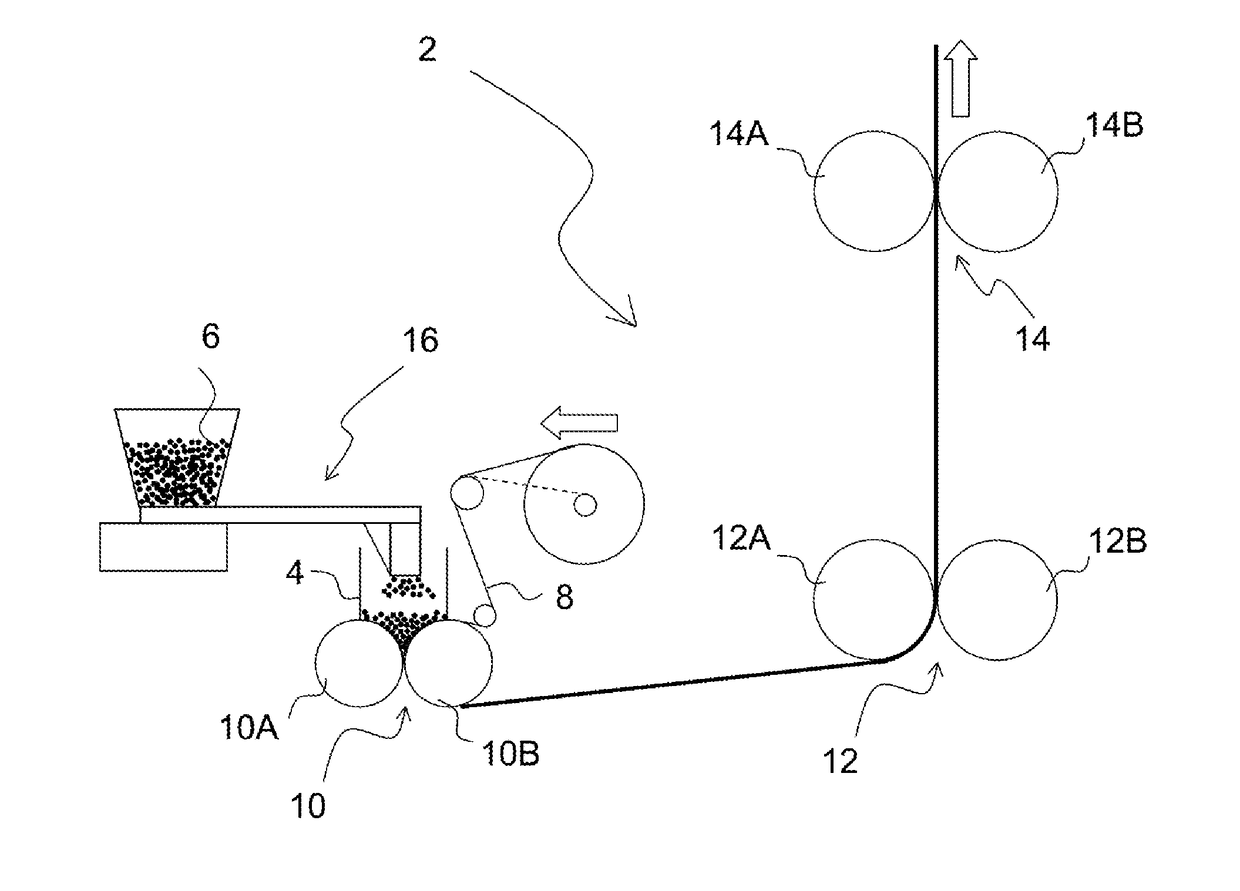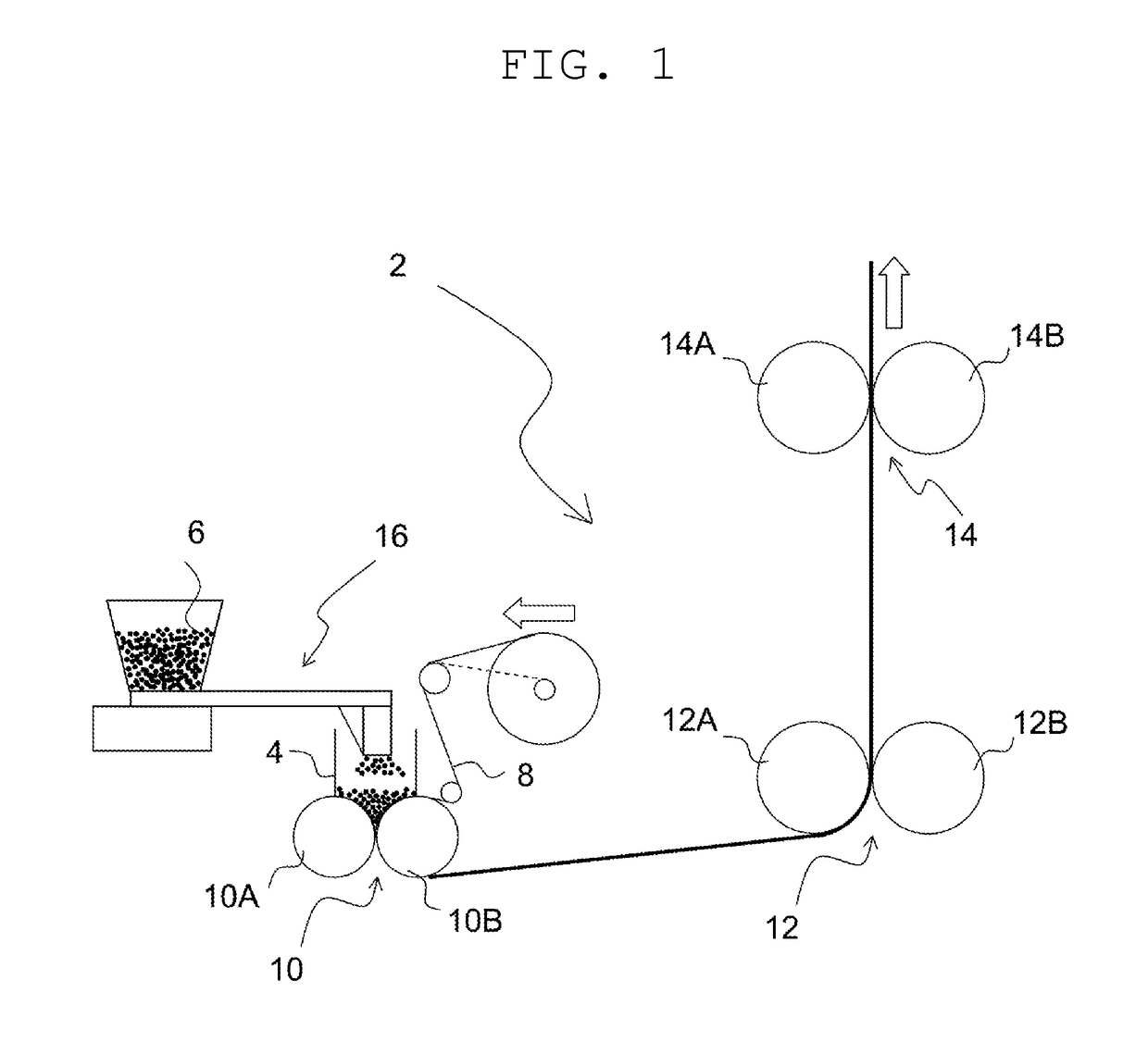Composite particles for electrochemical device electrode, electrochemical device electrode, electrochemical device, method for manufacturing composite particles for electrochemical device electrode, and method for manufacturing electrochemical device electrode
a technology for electrochemical devices and electrodes, applied in sustainable manufacturing/processing, cell components, batteries, etc., can solve the problems of affecting the working environment, requiring a high cost, and difficult to manufacture a uniform electrochemical device, and achieves high thickness precision, low base weight, and low cost
- Summary
- Abstract
- Description
- Claims
- Application Information
AI Technical Summary
Benefits of technology
Problems solved by technology
Method used
Image
Examples
example 1
Manufacture of Binder Resin
[0128]62 parts of styrene, 34 parts of 1,3-butadiene, 3 parts of methacrylic acid, 4 parts of sodium dodecylbenzenesulfonate, 150 parts of ion-exchanged water, 0.4 parts of t-dodecylmercaptan as a chain transfer agent, and 0.5 parts of potassium persulfate as a polymerization initiator were put into a 5 MPa pressure resistant container with a stirrer, and stirred sufficiently. Thereafter, the resulting mixture was heated to 50° C. to start polymerization. The reaction was terminated by cooling when a polymerization conversion rate became 96% to obtain a particulate binder resin S (styrene-butadiene copolymer; hereinafter, sometimes abbreviated as “SBR”).
[0129]Preparation of Slurry for Composite Particles
[0130]97.7 parts of artificial graphite (average particle diameter: 24.5 μm, graphite interlayer distance (interplanar spacing (d value) of (002) plane by X-ray diffraction method: 0.354 nm) as a negative electrode active material, 1.6 parts of the particul...
example 2
[0138]Classification conditions in the manufacture of composite particles were changed. Specifically, using a screen mesh with an opening of 135 μm, the coarse particles on the screen mesh were removed. In addition, the composite particles under the screen mesh were screened using a screen mesh of 75 μm, and the particles under the screen mesh were removed. The manufacture of composite particles was performed in the same manner as in Example 1 except for changing classification conditions. Particles of 40 μm or less of the composite particles was 0% of the entire amount in a number-based particle size distribution, the cumulative 95% size (D95 size) was 137 μm in a volume-based particle size distribution, and the cumulative 50% size (D50 size) was 87 μm in a volume-based particle size distribution. Further, the compression degree was 12%, and the sphericity was 5%. A negative electrode for lithium ion secondary battery was prepared in the same manner as in Example 1 except for using...
example 3
[0139]Classification conditions in the manufacture of composite particles were changed. Specifically, using a screen mesh with an opening of 135 μm, the coarse particles on the screen mesh were removed. In addition, the composite particles under the screen mesh were screened using a screen mesh of 53 μm, and the particles under the screen mesh were removed. The manufacture of composite particles was performed in the same manner as in Example 1 except for changing classification conditions. Particles of 40 μm or less of the composite particles was 13% of the entire amount in a number-based particle size distribution, the cumulative 95% size (D95 size) was 94 μm in a volume-based particle size distribution, and the cumulative 50% size (D50 size) was 61 μm in a volume-based particle size distribution. Further, the compression degree was 13%, and the sphericity was 7%. A negative electrode for lithium ion secondary battery was prepared in the same manner as in Example 1 except for using...
PUM
 Login to View More
Login to View More Abstract
Description
Claims
Application Information
 Login to View More
Login to View More - R&D
- Intellectual Property
- Life Sciences
- Materials
- Tech Scout
- Unparalleled Data Quality
- Higher Quality Content
- 60% Fewer Hallucinations
Browse by: Latest US Patents, China's latest patents, Technical Efficacy Thesaurus, Application Domain, Technology Topic, Popular Technical Reports.
© 2025 PatSnap. All rights reserved.Legal|Privacy policy|Modern Slavery Act Transparency Statement|Sitemap|About US| Contact US: help@patsnap.com


